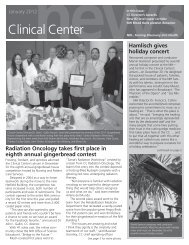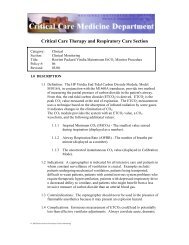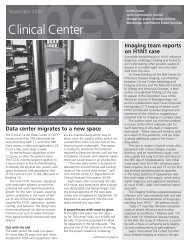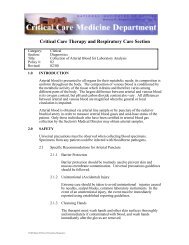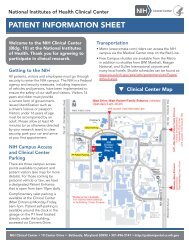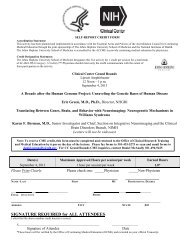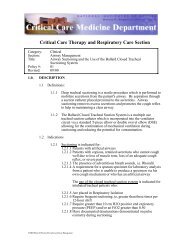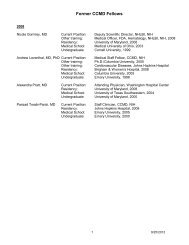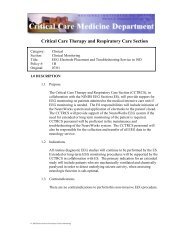2011 - NIH Clinical Center - National Institutes of Health
2011 - NIH Clinical Center - National Institutes of Health
2011 - NIH Clinical Center - National Institutes of Health
You also want an ePaper? Increase the reach of your titles
YUMPU automatically turns print PDFs into web optimized ePapers that Google loves.
RESEARCH DAY EXPOSES DIETITIANS TO CLINICAL RESEARCHThe <strong>Clinical</strong> <strong>Center</strong> Nutrition Departmentwelcomed 85 attendees from around the countryto an <strong>NIH</strong> Research Day on March 18, 2010.<strong>National</strong> Cancer Institute/CC Nutrition andCancer Prevention Research Practicum participantsand local dietetic interns heard a morning <strong>of</strong>presentations from staff before touring the hospitaland the Metabolic <strong>Clinical</strong> Research Unit to get aglimpse <strong>of</strong> the work <strong>of</strong> clinical research dietitiansAttendees heard a welcome and introduction tothe CC from dietetic internship director LCDRMerel Kozlosky, before learning about the role <strong>of</strong>dietitians in research from Nancy Sebring. In anacute care hospital, clinical dietitians spend about80 percent <strong>of</strong> their time on clinical patient care,with the rest devoted to hospital and departmentsupport. <strong>Clinical</strong> research dietitians, on the otherhand, Sebring said, split their time between thoseresponsibilities and research support, though thebreakdown varies by staff member.Sebring presented some types <strong>of</strong> nutrition-focusedresearch.“For example, in one <strong>of</strong> our studies lookingat obesity we’re interested in patients’ tastepreferences—do certain people taste sweet or sourdifferently than others?” Sebring said.In the “Parade <strong>of</strong> Protocols “presentations, CCclinical research dietitians spoke on their roles invarious <strong>NIH</strong> studies. Beth Moylan found it importantto evaluate the existing low iodine diet, whichis used in conjunction with the treatment forthyroid cancer patients, due to food manufacturingchanges and an international patient populationconsuming foods grown in different soil compositions.LCDR Jennifer Graf explained balancingtypes <strong>of</strong> protein for those with methylmalonicacidemia who need enough protein for normalanabolic function but not too much <strong>of</strong> particularamino acids they cannot properly break down.LT Rachel Drabot recounted helping a cancerresearch patient who experienced a multitude <strong>of</strong>treatment side effects by providing her with liquidnutrition supplements, individualized nutritioncounseling, meal plans, and support.Dr.Amber Courville, metabolic research dietitian,presented the Metabolic <strong>Clinical</strong> Research Unit,where more than a dozen obesity-related studiesare being carried out, such as one examining howgenes and the environment interact to determinebody weight.The unit continues to grow andseveral more protocols with nutrition componentsare currently under development.Dr.Amy Subar, nutritionist from the <strong>National</strong>Cancer Institute, spoke on new methods <strong>of</strong> dietaryassessment, including using cell phone photos totrack what someone eats. Marnie Dobbin, CCclinical research dietitian, presented an overview<strong>of</strong> botanical and “other” dietary supplements andresources available to guide safe supplement use.BTRIS—the Biomedical TranslationalResearch Information System—waslaunched in 2009 and is is available to the<strong>NIH</strong> intramural community, bringing togetherclinical research data from the CC and otherinstitutes and centers.“BTRIS is designed to bring together clinicalresearch data from all the institutes andcenters to give investigators one place toget all their data and allow other users to asknew questions <strong>of</strong> the old data,” said Dr. JimCimino, chief <strong>of</strong> the <strong>Clinical</strong> <strong>Center</strong> Laboratoryfor Informatics Development.BTRIS provides clinical investigators withaccess to identifiable data for the subjects ontheir own active protocols, while providing all<strong>NIH</strong> investigators with access to de-identifieddata across all protocols. The advancedsearch, filtering, and aggregation methodsto create data sets support ongoing studiesand stimulate ideas for new research.Dr. Jim Cimino demonstratedthe sorting capabilities <strong>of</strong> BTRISto a group <strong>of</strong> NINDS intramuralresearchers in June 2010ANNUAL REPORT <strong>2011</strong>• 29



